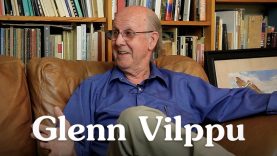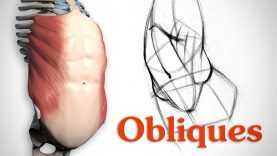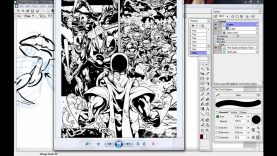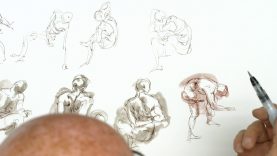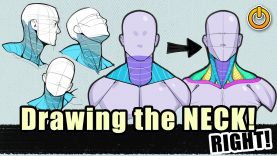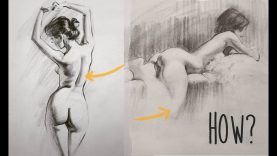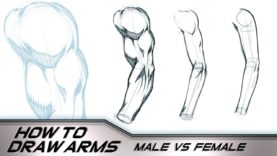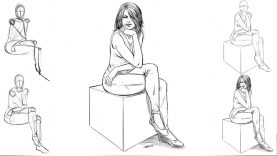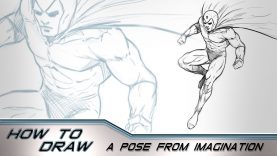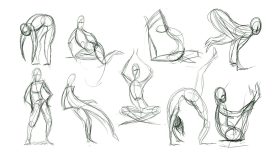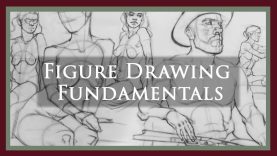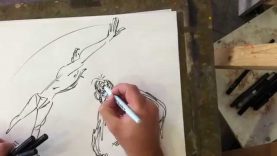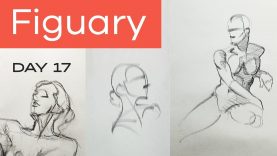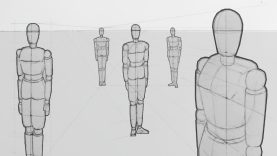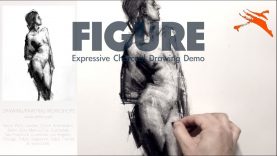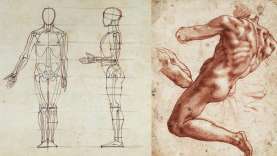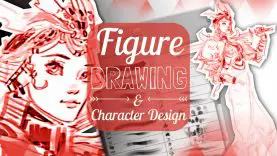Timed Model Drawing with Steve Huston – New Masters Academy
Follow Steve Huston in this figure drawing session from the New Master Academy channel. He will show you how to capture the gesture and how to build the figure structure from the reference images he is copying from.
Video description:
Introducing a new way to study figure drawing…
At New Masters Academy we’re always looking for new ways to help teach the fundamentals of art. Recently we have begun releasing (via YouTube) a series of timed reference videos that we call the Daily Life Drawing Sessions: https://www.youtube.com/playlist?list… .
These sessions allow artists to practice drawing 1, 2, 5, and now 10 minute figure drawing poses that we have selected from the vast Image Reference Library: http://www.newmastersacademy.org/refe…
These sessions have been met with with overwhelming enthusiasm which sparked a new idea:
Now we have begun recording real-time video lessons where your New Masters Academy instructors draw from the timed sessions right alongside you. Here’s how we recommend you use this resource: First do the DLDS video yourself one or multiple times trying to stay true to the timer and improving on your initial drawings and understandings of the poses each time.
Next watch your favorite instructors do the same drawings from the same videos as you, comparing what similarities and differences there are between not only you and your favorite instructor, but also among the different instructors.
This is an approach that has never been implemented in art education and so far the feedback has extremely positive. We currently have the first 5 sessions recorded by both Steve Huston and Glenn Vilppu and we will be adding more instructors and more sessions on a regular basis.
For all sessions including over 500 hours of video lessons visit: http://www.newmastersacademy.org
How to Draw the Figure |
Start learning now at: http://www.newmastersacademy.org
Transcript:
Hi, I’m Steve Huston. Welcome to another drawing session. This time what we’re going
to try and do is focus on cohesion, getting every mark to come together, make the whole
thing one composition, one pose, one exciting piece of art.
So let’s get started.
Alright, I’m drawing just with a cheap ballpoint pen. Fountain pens work great too.
And I’m drawing something simple enough that it gets the idea of not just a head but this young
lady’s head. Simple, yet characteristic. The simpler you make it the more control you
have over it. The quicker you can do it. The more you can design or redesign it, and the
more characteristic it is. The more finished it will seem so you can stop in the
beginning stage and still get the idea down.
So if you only have a minute or so like we have here,
keeping it characteristic, taking that extra few moments to make it characteristic is going
to go a long way to reading the information for the audience.
Trying to show you exactly where that shoulder becomes an arm, so we’re trying to get some
kind of corner that tells us where that jointed part is changing.
Now as I warm up doing these one-minute poses I’m going to probably get more and more information down
as I go through the poses.
The first few poses I’ll probably go a little slow, a little more tentative.
I’m getting used to my materials and just stretching those artistic muscles so that
is going to limit me. So don’t worry about finishing.
I’m going to make this a looser head. It’s going to lose some of its connection, but
I’ll get down a little farther. I’m going to let this get a little more wild.
It’s almost going to be a caricature. So you can kind of play, you know, play with the limits
of how far you want to take things, a little mark for the elbow.
This is coming back this way, across this way.
Just let it go right off the paper. Don’t worry about it.
So just kind of feeling the flow of it in this case. Nothing is really anchored in, committed
to, just trying to get the rhythm of it.
Or, more slow and deliberate. Yeah, we’re trying to find a balance.
The faster you go, the more you can finish. The faster you go the more inaccurate it will be and the more
formulaic. You’ll go to the same solutions over and over and over again. The faster you
go the more you can invent, get the energy without the specifics. So you want to find
that balance, how much structure.
My stuff has a lot of energy, my personal work, and
it’s very, very structured. Oftentimes it is kind of superhero-type figures. I’m balancing
both of those. I don’t want the muscles and the structures to get stiff. I don’t
want the energy to get disconnected and upended. I want them to flow from form to gesture and
gesture to form and be fairly seamless. I’m trying to find a balance between getting that
energy of expression, that sense of movement with solid information we can use.
Sometimes I’ll just draw one part and take that one minute and just do maybe the head.
She has these lovely high cheekbones, so I’m going to really kind of explore that socket
that holds the eye, the bangs. The hairstyle flowing back. There is a squareness to how
the hair is gathered in the back. Play that up. The ear in here and then the little nose
and lips, chin, and then don’t leave it cut away.
Show how it flows into the next form that you may or may not have time to explore.
You can see how we can get something
that’s more accurate but more limited.
Alright, two minutes. I have more time so I’m going to take more time,
not in the rendering in this simple construction.
One of the things that I want to notice is what the whole pose is doing, the whole pose is leaning up and to
the left. So if I’m going to screw up, that’s the way I want to screw up. I want to make her lean too much.
If there is deep perspective I want to make the perspective too deep. If there is some dynamic pinch,
I want to make the pinch too pinching. If she is long and graceful I’d rather make
her a little too long, a little too curved than a little too short and a little too straight.
So these long axis curves are the visual cues.
They tell us graceful, fluid, living, dynamic, and active.
She is holding this pose for a moment for us, but she is going to be somewhere
else in the next moment, so we want to capture that dynamic moment, that precious sense of
the now here. It sounds like some self-help group.
We’ll call ourselves the Precious Senses of the How’s.
Okay, and sometimes I’ll just get caught up in an area, these hips doing a little bit
of the construction so I can feel that dynamic connection into the upper torso. And I failed
to get the legs. I screwed up. Well, no I didn’t. I just didn’t finish.
Art is never finished. Just do what you can in the time you have.
Alright, two minutes. The more structure I need the more dynamic perspective I need,
the more corners I need. If you go to my basic drawing classes, lessons I should say at the
New Masters I talk about that in great detail. It’s a big subject.
It’s not something we can just throw away a few remarks on.
My main focus here, well, I don’t know if there’s
a main focus cause there is so many, it’s like juggling eggs. There are several in the
air at once. But one of my purposes here is the marks I put down, I want them to ring
true, whatever that means. And it’s going to mean something a little different to me
than you. There will be certain proportional truths. There will be certain dynamic anatomical
truths, some kinetic truths, that kind of stuff, balancing truths. But we’re not talking
about that as much as emotional truths. That’s where art has the great power. So does it
ring true emotionally? The sense of the figure leaning back or falling over. The sense of
a beautiful young woman or a troubled young man or whatever the personality is behind it.
That’s what we’re after. I’m not finishing. I’m suggesting that kind of emotional
territory or those kind of structural dynamics.
If I try and finish I’ll fail miserably. If I try and suggest then I have a chance.
Okay, another two-minute.
Here’s the head-shoulder line, the ponytail or hair bound up there
or whatever you’d call that. She has a real hourglass figure that is going to give me
a good chance to screw it up cause I’m going to make the shoulders too wide and too male,
and I’m going to probably pinch the hips off at the waist. I want to make sure I’m
really doing that waist justice.
I’m refining that gesture line, that connective line, that long axis design line that is a
gesture to make sure it’s where it needs to be.
Feel the weight there.
Make that dark mark so we can feel that anchoring weight that’s supporting the pose, her lap.
Alright, two minutes.
What you might want to do as you’re drawing this, take
the one minute to two minute to five minutes to do the drawing, of course. You can cheat a little
bit and pause it if you’re having trouble and turn the minute into a minute and a half.
Don’t turn the minute into 20 minutes unless it’s something that you really want to do.
But try a separate exercise cause it’s just a terrific pose you want to work with. But try
and feel those big, sweeping ideas. What are the key components that make this pose this pose?
What is supporting it? What is holding it in a quiet moment rather than it in action?
Why isn’t it feeling like it’s actually falling over, but it feels balanced in some
way? There is some support system going on.
I’m just letting the shadow, that’s a whole other topic, shadows that we won’t
delve into here but letting those shadows serve the same function everything else does,
a gesture in the structure
Coming off that hidden leg or that hidden hip to find that emerging leg.
So try and get a sense of the pose. The head is pinching against the shoulders. It’s a seated pose,
of course. It’s leaning over her lap, so leaning, little bit of dynamic torque going
on there as she twists around from shoulder into that head position.
I like the shadow here because that zigzag shows the compression of that hip or that hip being thrust upon
by the upper torso, so we get that nice dynamic there, and it gives us that torque. It shows
the power in this quiet pose.
Alright, five minutes.
So I’m kind of noticing with this hair, face, neck, everything is
kind of going in different directions, flowing back, zigzagging over, criss-crossing across.
Criss-crossing across, can you say that? I guess so. And the bangs flowing down. So a
lot of fun directions going on? Going to play that up and then maybe the broad simplicity
of this back. There is a series of dynamics over here I’ll exploit but a lot of this
back is beautifully simple, so I’ll play this complexity of the head with all its stuff
against the simplicity of that torso with its subdued stuff.
I might, like an Ingres…It’s spelled like that.
Really simplify the contours so it’s this long kind of waterfall this gentle
waterfall of forms that don’t. There are no splashes in an Ingres like there
would be in a Michaelangelo or more dynamic artists,
a Leyendecker, Dean Cornwell, Frank Brangwyn,
that kind of stuff. Or even a Frans Hals.
So the intention can be completely different even though the subject matter, the reference
even, can be exactly the same. I am going to come back to this spicy area. I am going
to keep this shadow also pretty quiet, maybe even pretty light.
Since it’s a subtle shape maybe it has a subtle value to it. I’m planning the rendering.
Then in this area I get relatively charged with stuff.
Even the marks over here are subdued, light, highly edited.
So I just play these little design games even though it’s just a sketch, just a little study,
just practice time. It’s nice if I have a bigger idea in mind.
I’m working those artistic muscles hopefully on a couple of different levels. In other words, not just
pin line, not just construction. Not just proportion but on several things.
Great art works on several levels at once. You might pick one thing to work on in one
drawing, but it doesn’t always have to be the same thing or the same thing few things.
It can be very rich and varied in the choices.
And it should be, really. You know, why are we
looking at your figure drawing rather than the millions of others that are on the internet and done
through history? What are you going to bring to the table? Maybe not now as you’re beginning
your career, but eventually as you’re well into your career, what are you going to bring
to the table that’s different, that can be unique? In other words, what are you going
to teach me? That’s what I want to know from the artist. I want the artist—we all
want the artist to teach us how to see the world and by implication how to live in the
world. That is the value of art. No just pretty pictures. But informing us on how to live
a good life, an interesting life, a challenging life, a whatever life.
Difficult form, pretty girl’s face. Difficult position tilted in this strong and yet graceful
perspective placement. I’m going to slow down. Difficulties demand more careful thinking,
more thoughtful execution. I don’t want to put anything down that doesn’t ring true.
It should ring true, and that’ll mean something a little different to you, probably, than
it does to me and should. That’s why I’m going to come to your gallery opening, and
somebody else might choose to come to mine instead because how we see the world as a
unique experience and because we’re all unique that’s valuable. We’re going to
show the world something. We have a voice that has value in it.
Oftentimes I’ll draw very fast because I want to try and get energy into it. I want
to try and surprise myself with how I make a mark or design a shape or whatever.
Here I am drawing much slower cause it is a subtle pose. I find the really dynamic poses, the
left side pose we could have chosen. I picked this one because this is harder, I think.
It’s a subtle pose, and that subtlety means that there are minute changes, relatively
small changes, and those small changes are each then compounding against the others in
creating a complex forms, a design, a pose.
But they have probably less room for error.
I can’t muck them up as easily. So if I make the hips too big it’s going to make
it more dynamic maybe for a pose like this. It’s going to make it just chubby on the
bottom or ungraceful at the top as it is. So now I need to adjust and correct that choice,
and I’m going to put a little hatching to hide my screw-up, my error there.
I’m taking some of my valuable time to make that correction because it’s important that this drawing
ring true as best I’m able with the time we’re given.
So these short poses are designed to make you make choices. Make creative artistic choices.
And so they have to be thoughtful, at least at first. When you’re learning you want
to consider and think through why. Why is that working? Why is it not working? What
am I missing? What could be better? How did I make such a great mark there?
Why is that mark so powerful and so successful? Thinking it through and dialoguing with teachers, other
artists, with the great masters of the past. Let them speak to you. All that kind of stuff.
If I have more time I’ll work on the connective tissue.
Add some of the shading here.
Might want to put this arm in. Drawing around the arm I didn’t even notice I didn’t get
the arm in. It’s funny what we see and don’t see in life, isn’t it? You guys are probably
screaming at me to put the arm in, and I thought I had.
If you’re getting discouraged or you feel like this is too advanced for you, when you’re
working from a figure like this it is intermediate level oftentimes. If you need a little bit
more foundational advice on how to begin, maybe even simpler subjects to work with with
the figure, come to the New Masters Academy website. We have a lot of content for all
levels. I hope you’re drawing all week long. I’ll see you next time, and good luck.
Up next



